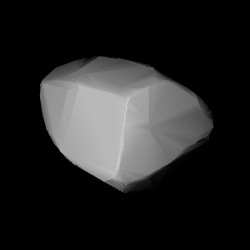 Shape model of Di Martino from its lightcurve | |
| Discovery [1] | |
|---|---|
| Discovered by | E. Bowell |
| Discovery site | Anderson Mesa Stn. |
| Discovery date | 30 December 1981 |
| Designations | |
| (3247) Di Martino | |
Named after | Mario di Martino [1] (Italian astronomer) |
| 1981 YE ·1968 HR 1979 HO1 ·A909 BL | |
| Orbital characteristics [2] | |
| Epoch 23 March 2018 (JD 2458200.5) | |
| Uncertainty parameter 0 | |
| Observation arc | 109.09 yr (39,844 d) |
| Aphelion | 2.6824 AU |
| Perihelion | 2.0727 AU |
| 2.3776 AU | |
| Eccentricity | 0.1282 |
| 3.67 yr (1,339 d) | |
| 229.54° | |
| 0° 16m 7.68s / day | |
| Inclination | 3.9342° |
| 45.601° | |
| 146.34° | |
| Physical characteristics | |
| 11.267±2.644 km [6] 11.74±3.06 km [7] 12.42±2.19 km [8] 13.60±5.23 km [9] 13.72 km(derived) [3] 13.75±1.0 km [10] 15.60±0.51 km [11] | |
| 5.443±0.0014 h [12] 5.4446±0.0007 h [13] 5.445 h [14] 5.44517±0.00005 h [15] | |
Pole ecliptic latitude | |
| 0.05±0.10 [8] 0.053±0.004 [11] 0.0540(derived) [3] 0.060±0.060 [9] 0.0647±0.011 [10] 0.08±0.09 [7] 0.0925±0.0544 [6] | |
| S (assumed) [3] | |
| 12.90 [10] [11] 13.00 [7] [9] 13.1 [2] [3] 13.116±0.003(R) [12] 13.26 [6] 13.51 [8] | |
3247 Di Martino (prov. designation: 1981 YE) is a dark Nysa family asteroid from the inner regions of the asteroid belt. It was discovered on 30 December 1981, by American astronomer Edward Bowell at Lowell's Anderson Mesa Station near Flagstaff, Arizona, in the United States. [1] The asteroid has a rotation period of 5.4 hours and measures approximately 13 kilometers (8 miles) in diameter. [3] It was named for Italian astronomer Mario di Martino. [1]